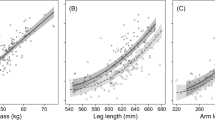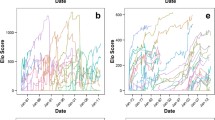Summary
After an interval (X = 6 months), high ranking male chacma baboons (Papio cynocephalus ursinus) lose their status to immigrants. Attainment of alpha rank by immigrants is a qualitatively different process from thestepwise increase in status noted in linear dominance hierarchies. The departing rank of natal emigrants was 5.4, while the first measured rank, shortly after transfer into a new troop, was 1.5. Abrupt rises to alpha rank involve direct challenges to the current alpha male. Fourteen of 19 prime immigrants attained alpha rank at first transfer. Rank rises may result if individuals forego contests, retaining lower hierarchical positions in their natal troop to avoid the costs of conflict prior to natal emigration. In this population some males do breed in their natal troops without differing from immigrants in their reprodocutive success. Five males that rose to high rank within their natal troops also made rapid rank rises to the top of the hierarchy. Withholding of aggressive efforts in natal troops to avoid inbreeding thus is not an adequate explanation of the rank rises we observe in this population. The high probability of successful challenges can be explained by assuming an asymmetry in costs of losing (resource value) to tenured alpha males or a greater fighting ability of challengers.
Similar content being viewed by others
References
Altmann J, Hausfater G, Altmann S (1988) Determinants of reproductive success in savannah baboons, Papio cynocephalus. In: Clutton-Brock TH (ed) Reproductive success. University of Chicago Press, Chicago, pp 403–418
Barnard CJ, Brown CAJ (1984) A payoff asymmetry in resident-resident disputes between shrews. Anim Behav 32:302–304
Beletsky LD, Orians GH (1987) Territoriality among male red-winged blackbirds. II. Removal experiments and site dominance. Behav Ecol Sociobiol 20:339–349
Bercovitch FB (1988) Coalitions, cooperation and reproductive tactics among adult male baboons. Anim Behav 36:1198–1209
Bulger J, Hamilton WJ III (1987) Rank density correlates of inclusive fitness measures in a natural chacma baboon (Papio ursinus) troop. Int J Primatol 8:635–650
Bulger J, Hamilton WJ III (1988) Inbreeding and reproductive success in a natural chacma baboon Papio cynocephalus ursinus population. Anim Behav 36:574–578
Cheney DL, Seyfarth RM (1983) Nonrandom dispersal in free-ranging vervet monkeys: social and genetic consequences. Am Nat 122:392–412
Clutton-Brock TH (1989) Female transfer and inbreeding avoidance in social mammals. Nature 337:70–72
Clutton-Brock TH, Harvey PH (1976) Evolutionary rules and primate societies. In: Bateson PPG, Hinde RA (eds) Growing points in ethology. Cambridge University Press, Cambridge, pp 195–237
Davies NB (1978) Territorial defence in the speckled wood butterfly (Pararge aegeria): the resident always wins. Anim Behav 26:138–147
Dittus W (1977) The social regulation of population density and age-sex distribution in the toque monkey. Behaviour 63:281–322
Dunbar RIM (1988) Primate social systems. Comstock Publishing Associates, Ithaca, NY
Grafen A (1987) The logic of divisively asymmetric contests: respect for ownership and the desperado effect. Anim Behav 35:462–467
Hausfater G (1975) Dominance and reproduction in baboons (Papio cynocephalus). Contributions to primatology, vol 7. S. Karger, Basel
Krebs JR (1982) Territorial defence in the Great Tit (Parus major): do resident always win? Behav Ecol Sociobiol 11:185–194
Nöe R (1989) Coalition formation among male baboons. PhD Dissertation, University Zurich-Irchel
Packer C (1979a) Inter-troop transfer and inbreeding avoidance in Papio anubis. Anim Behav 27:1–36
Packer C (1979b) Male dominance and reproductive activity in Papio anubis. Anim Behav 27:37–45
Parker GA (1974) Assessment strategy and the evolution of fighting behavior. J Theor Biol 47:223–243
Pereira ME (1988) Agonistic interactions of juvenile savanna baboons I. Fundamental features. Ethology 79(3):195–217
Pereira ME (1990) The development of dominance relations prior to puberty in cercopithecine societies. In: Silverberg J, Gray P (eds) A primate behaviour potential: aggression and nonaggression in human and other primates. Oxford University Press, Oxford (in press)
Pusey AE, Packer GA (1987) Dispersal and philopatry. In: Smuts BB, et al. (eds) Primate societies. University of Chicago Press, Chicago, Illinois, pp 250–266
Rohwer S (1982) The evolution of reliable and unreliable badges of fighting ability. Am Zool 22:531–546
Smith KS (1986) Dominance and mating strategies of chacma baboons, Papio ursinus, in the Okavango Delta, Botswana. PhD Thesis, University of California
Van Noordwijk MA, van Schaik CP (1985) Male migration and rank acquisition in wild long-tailed macaques (Macaca fascicularis). Anim Behav 33:849–861
Author information
Authors and Affiliations
Additional information
Offprint requests to: W.J. Hamilton III
Rights and permissions
About this article
Cite this article
Hamilton, W.J., Bulger, J.B. Natal male baboon rank rises and successful challenges to resident alpha males. Behav Ecol Sociobiol 26, 357–362 (1990). https://doi.org/10.1007/BF00171102
Received:
Accepted:
Issue Date:
DOI: https://doi.org/10.1007/BF00171102




